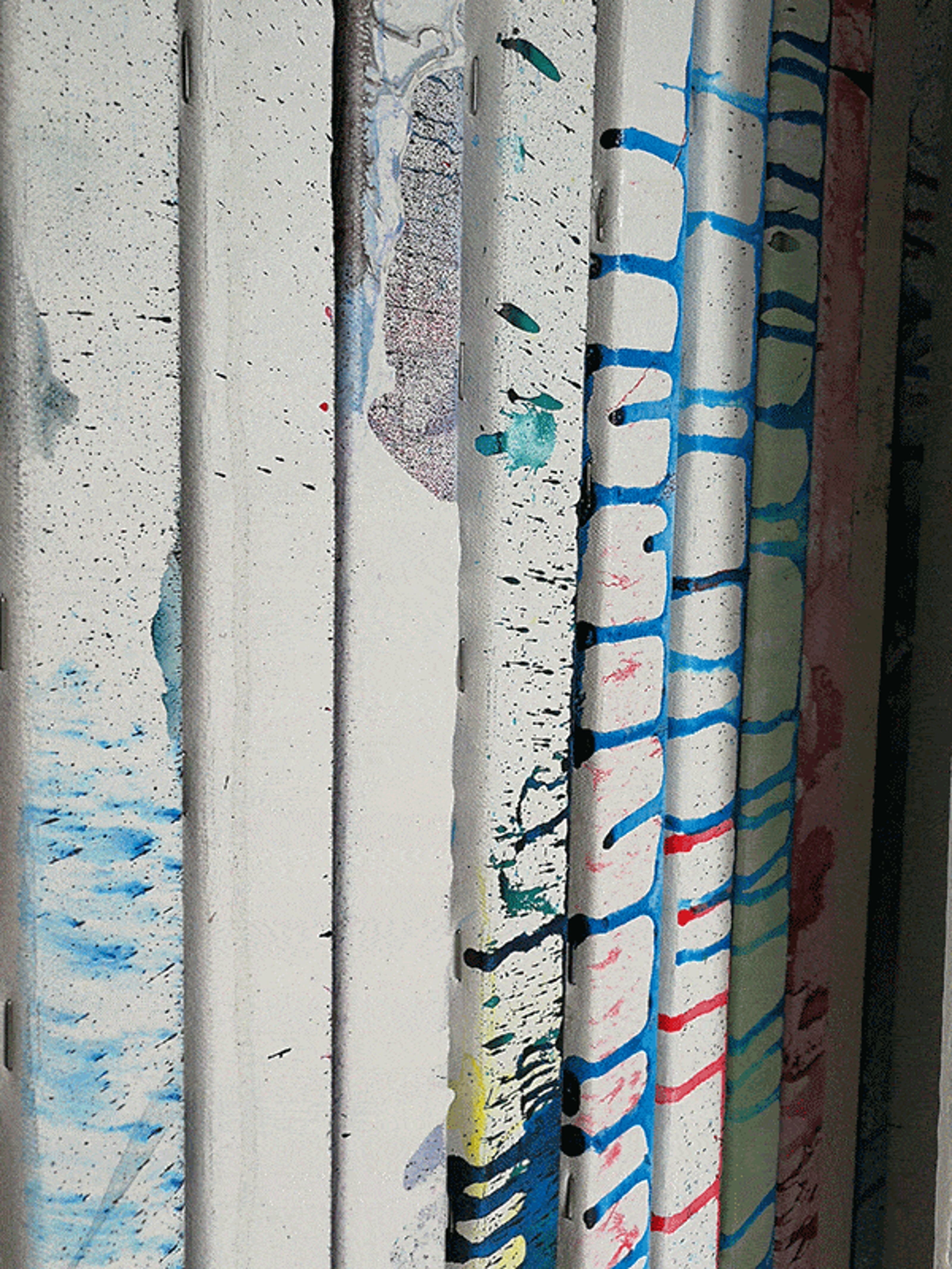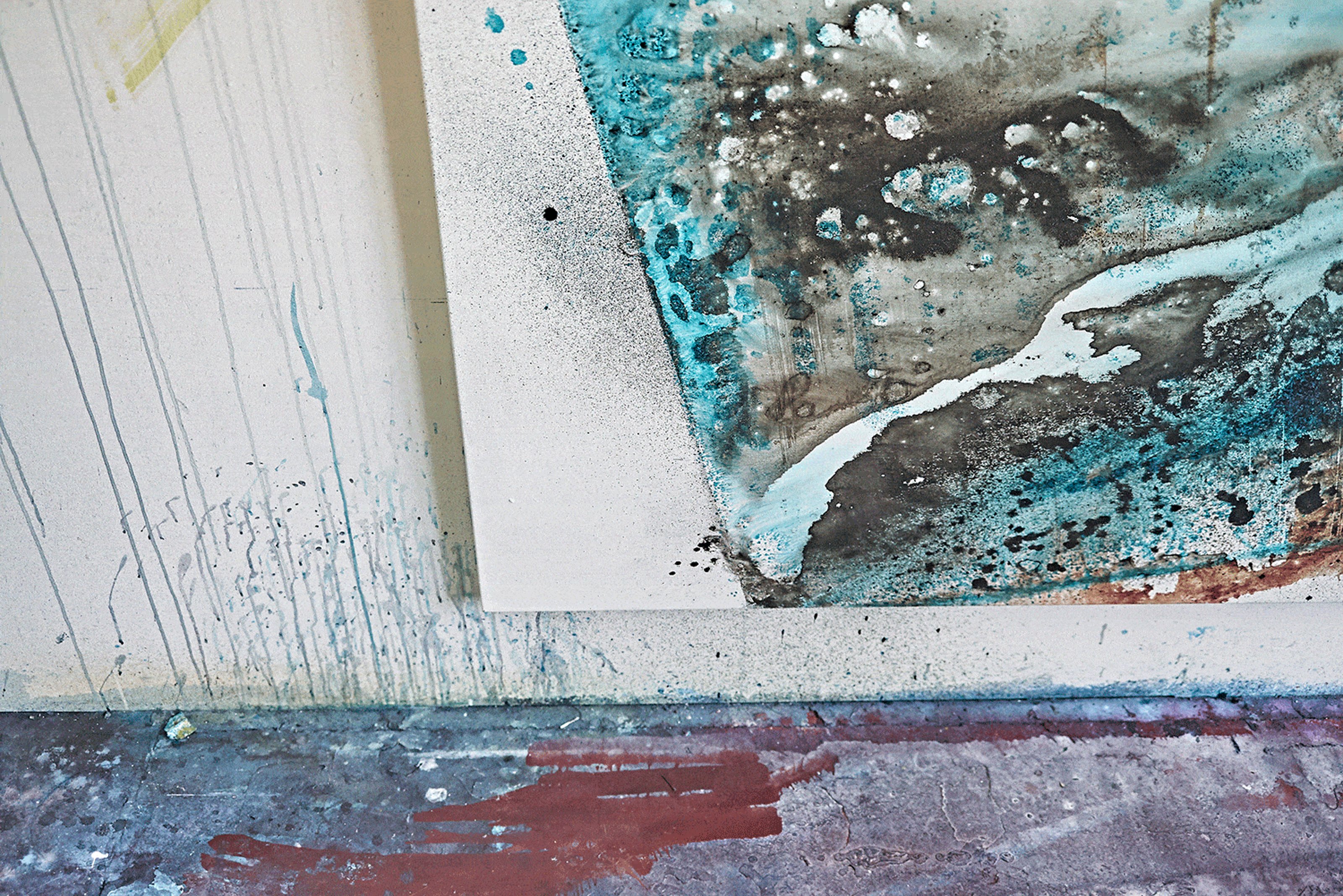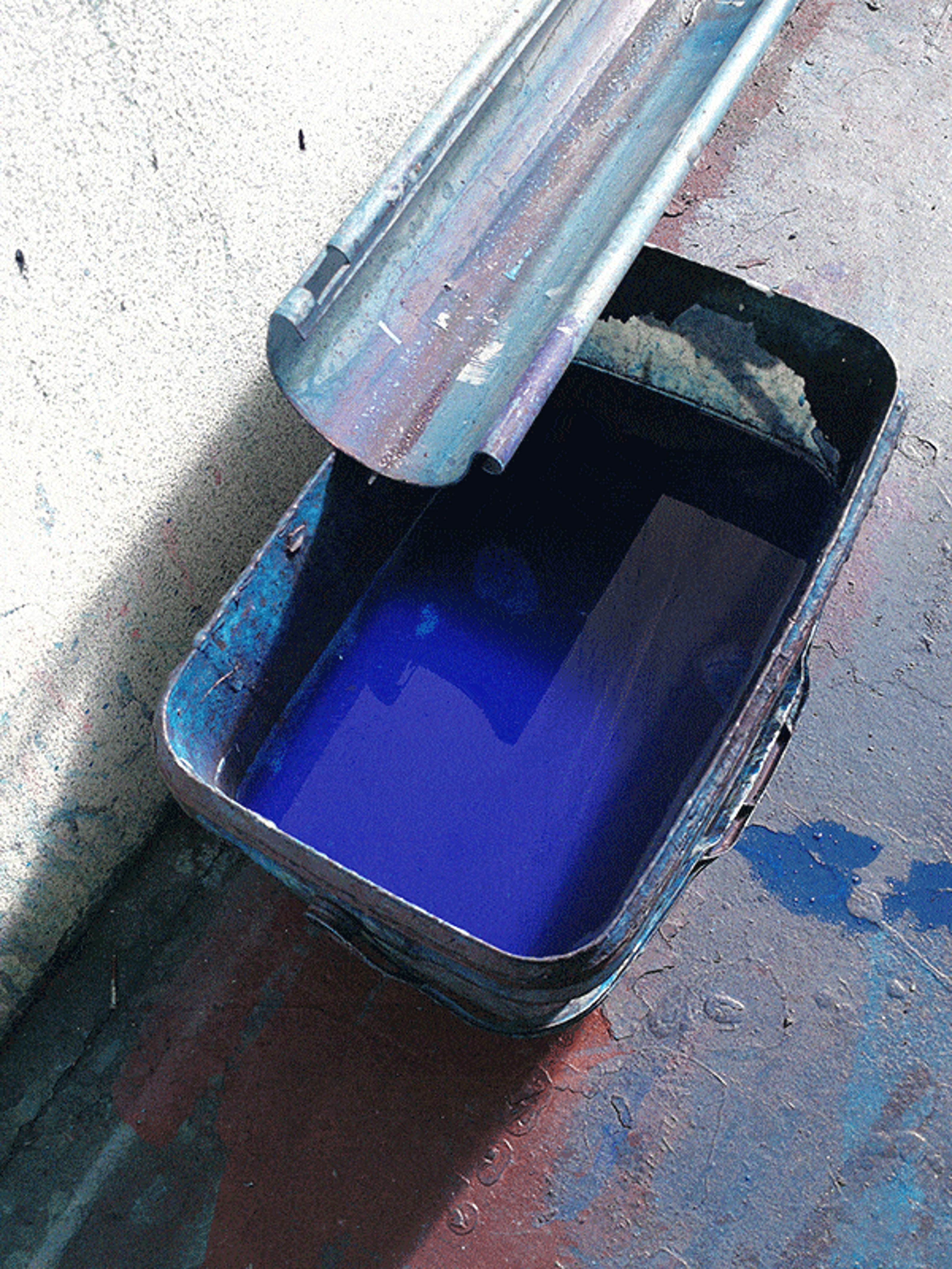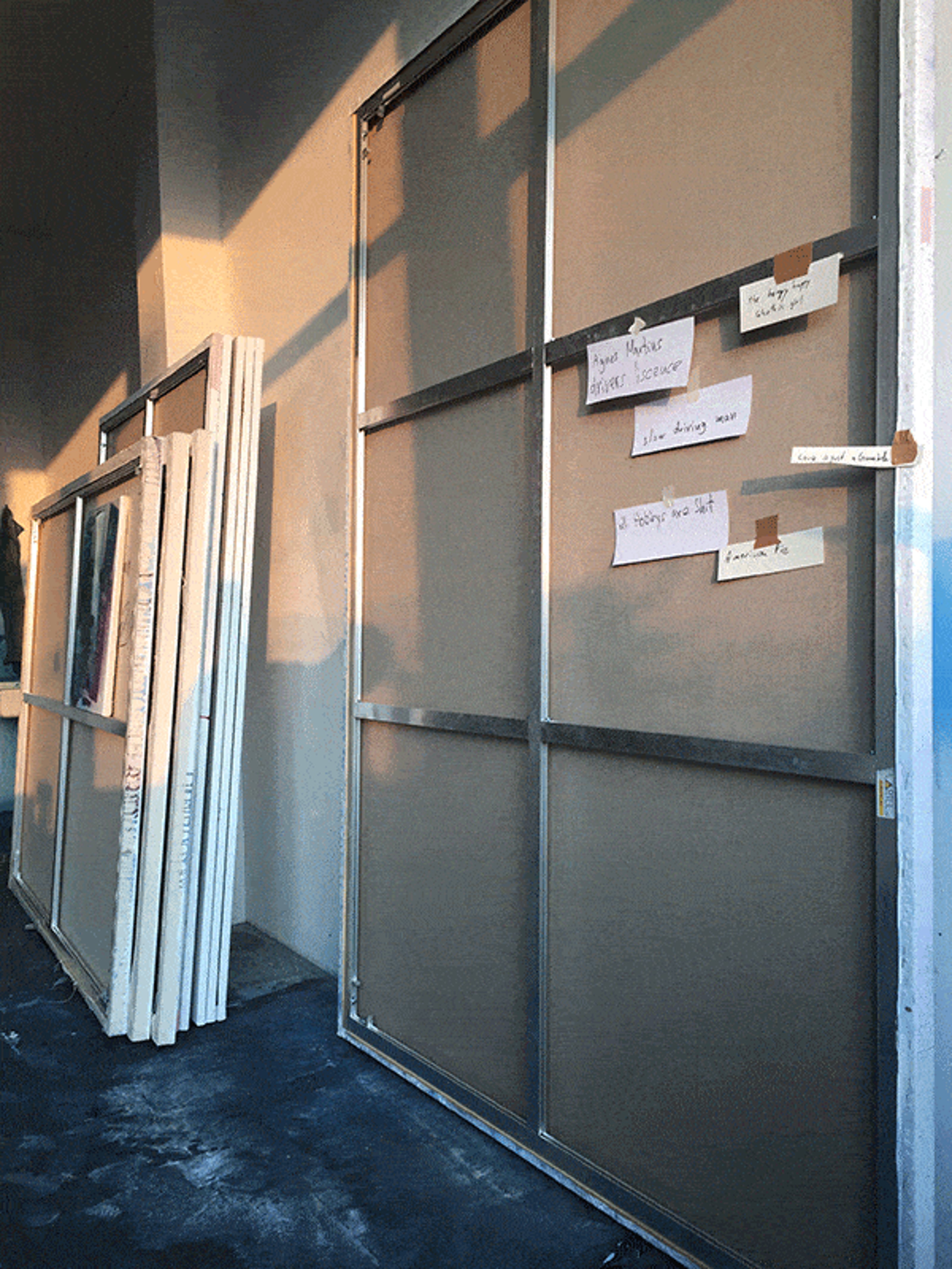Max Frintrop’s paintings are anything but a two-dimensional experience. Standing in front of the German painter’s usually large-scale paintings renders a temporary setting where an absence of the viewer’s immediate reality emanates, only soon after finding themselves partaking within the consequences of the artist’s sensibility: a chromatic universe suffused by abstractions that—somehow indisputably—embraces a fluid mutuality of emotions. While it might come off as a desperate endeavor to include whatever type of cliché (and perhaps it just is ), it seems impossible to not feel when confronted with Frintrop’s work. We’re already too invested once stepping into close(r) proximity of the paintings, somatically as much as aesthetically. And so it’s here, within this very unexpected, nevertheless genuine, investment—especially when too considering an era of contemporary intentionalities which seem to solicit an underwhelmed rather than an overwhelmed landscape of selves—where Frintrop’s paintings leisurely grow into retrospective musings; throughout, remembering a world made of everyone’s memory. A silent congruence between us and the pictorial eruptions. Meanwhile taking everything from us, Frintrop gives it back. He gives it all back.

See Collecteurs Capsule Editions x Max Frintrop: a series of 12 unique paintings on paper
Lara Konrad: Typically I wouldn’t start off this way, but you’ve just become a father for the first time. Congratulations! How has it been?
Max Frintrop: Thank you. To be honest, becoming a parent for the first time is like driving a stick shift car during L.A. rush hour without a driver’s license. Well, at least for us, it was a bumpy start. But everything is more or less under control now, and we’re ridiculously happy. Considering the new circumstances, my focus has been off. Not in terms of art, but the overall scene and business… the vanities. Strangely enough, though, the real work—the painting—has been affected very positively by me becoming a father. The emotional enrichment, as well as the motivation, are tremendously compensating for the time that’s lost.

LK: Is it a surprise that your work seems so positively influenced by the recent birth of your son? I’m alluding—even if vaguely—to the seemingly common perceived notion that artistic expression derives more fluidly from residing within a melancholic rather than a ‘cheerful’ space.
MF: For me, being able to paint has always been about being sufficiently ‘charged.’ This energy can come from negative as well as positive incidents. Painting in anger can lead to happy results if you know when to stop. And, usually, that’s the hardest part. I used to spend more than 12-14 hours a day in the studio. But being motivated to cut extensive periods of procrastination has turned out quite well.
LK: Procrastination is interesting to think about since it often seems to fester throughout the creational process of art. I wonder if this so-called procrastination—a term usually conjuring negative connotation(s)— is almost necessary to take place, as it’s difficult to abandon naturally work that it is in the making. Perhaps procrastination could be seen as a rather positive act: time spent away from work which necessarily results in thinking about it placidly and therefore letting it become what it needs to become. There’s always the great possibility of work being destroyed if not experienced from a distance.
MF: Procrastination is actually not so great, but it’s a start. If you don’t do anything for a while, you’ll get lazy: a walk-to-the-muse or with-muse, that’s when the devil finds work for idle hands. One can be lazy, but the mind still gently eases around something. It’s a gentle form of boredom, and being bored and staying bored for quite a while is harder than ever these days. Our minds are constantly connected to every kind of distraction. They’re everywhere and in-between.

LK: After some extensive online research, I concluded that there aren’t as many interviews with you as I had expected. Are you not such a fan of talking in-depth to strangers about your work?
MF: Well, I guess there are a couple of aspects. Firstly, the paintings should do a lot of the work for themselves. In the end, it’s always art itself that has to stand the test of time. I like to keep my paintings open for the viewer so they can engage instinctively. If I’d say too much about what I thought about while painting, it would burden the perception of the audience. So I prefer keeping the description of my paintings technical. Additionally, giving interviews is still strange because I don’t feel like an “intellectual.” I’m a hard case of dyslexia and easily distracted in crowds.
LK: Art constantly moves forward and takes on new perspectives and sensibilities, especially when still on the younger spectrum of age, where emotionality might still ensue by an unadulterated impulse. Though, to be honest, I’m not sure art ever reaches finality.
MF: You’re absolutely right. A mentality that’s too certain, in this case too final, often hinders allowing things to happen organically. Art relies on freedom and genuine ambition, not esotericism swimming around aimlessly in a pool of vague intentions.
LK: In one of the few interviews I’ve read, you said you didn’t necessarily want to “be an intellectual artist.” I perceive you quite differently, as an artist who very much does ensue an intellectual discourse around his work, primarily because of the tangible sensibility of the mind. Your paintings are instinctively emotional, the reason perhaps why I suffuse it with such unrestrained intellectualism.
MF: I try to avoid certain biases as much as possible. In general, I pretty much crush my brain and gut whenever I paint, but I’m not on outsmarting concepts. I just want to paint. Nevertheless, it’s necessary to question one’s medium of work constantly. I’m reading interviews with Duchamp at the moment and I’m filled with admiration for his brilliance. He keeps referring to the “retinal artist” with such tender forgiveness and a little, but not at all mean contempt. It’s lovely.

LK: Being very much a traditional artist, what are your thoughts on the still newly popular involvement of digitalization?
MF: Digitalization is just a new tool. And a big one at that. New technologies always open doors for artists to be the first at something. Most of this won’t matter. Good old painting has been relevant for approximately 40,000 years, so it won’t fade easily. But the art world should definitely begin welcoming new technologies with a degree of sober skepticism.
New Technologies are a cheap way to write your name into history, at least for the “lucky” few artist who have the means to exploit them first. Whatever you do as an artist in a new field, or way of expression, due to a new technology, will make you relevant simply because you were the first one to do so. An impending example—though not through digitalization—will be the use of Vantablack. Everybody will be absurdly impressed by Anish Kapoor’s usage of the material or whichever artist that can afford to work with it. But that’s not what art is or should be about. It’s merely a new, hopefully temporary, attraction that I call “Disneyland for Adults.”
Everything in art that uses the spectacular as an end rather than meaning is highly suspicious. And so much video and digital art are somewhat about that too. I’d rather watch Ulrich Rückriem move for an hour than a pretentious video installation.
Even provincial museums that show medieval art. Perhaps these works aren’t as skillful as in famous museums but they’re certainly imbued with honesty. It’s a humbling experience and restores this notion that art is a necessity ingrained within human nature.
LK: There’s a performative aspect to being a contemporary artist. It’s somewhat impossible to bypass an active participation within the scene.
MF: Yes, but performance is also just a normal part of everyone’s life and it can be tough for everyone. Artists are nothing special in that way. Of course, an artist will always be part of the context in which his work is perceived. And an artist has to have some kind of access to the art world for the work to become part of the discourse. But never has someone entered the hall of fame solely by being good at partying. The real work still happens in the studio.

LK: Your life has been marked by different experiences. One of the things that struck me most by your childhood was the time you worked at a home for war children. I read somewhere that during the night shifts you’d draw the children, a decisive moment for you as a painter. What was the initial impulse to draw these children, as you were a child yourself too?
MF: It was a hard chapter, yet presented such valuable experiences. Kids are so tough. They’re constantly energized by an unbreakable will to live. But, at the end, I just worked there: the kids were great, and the “bosses” really sucked. Regarding the late night drawing session, well, I’ve always admired the act of sleeping, but in general, I also tried to draw as much as possible in order secure my entry into the academy.
LK: What is it about people sleeping that you find emotionally stimulating? I, myself, see a lot of beauty in it because of a person’s unusually tangible vulnerability.
MF: I agree, but—to be totally honest—I just had to become better at drawing. Drawing is like training a muscle. I needed hours of practice, and it’s best when the model doesn’t move too much. Drawing in front of a real person develops much more elegance and is definitely more challenging than drawing from a photo. But, yes, sleep is something wonderful to watch. It’s the artist’s salt meadow.
LK: The artist’s salt meadow?
MF: The north coast of France.
LK: That’s quite a romantic metaphor, immediately leading to the notion of beauty and how it coexists within anything, also especially within the context of art. Personally, I find the idea of beauty problematic and impossible to grasp within the context of art. Probably within the context of everything. The best I could define or recognize beauty is when an emotional reaction is accessed. Is that what you mean by beauty? Or what is your idea of beauty within art?
MF: Yes. Beauty is a rare thing. I love Wittgenstein’s idea: “Whereof one cannot speak, thereof one must be silent.” Maybe it’s better to speak of attraction, which seems more independent, like an individual.
LK: What literature has influenced your work?
MF: This one’s tough. It’s so tempting to just spill someone else’s juices on my work. But that’s always cheap, so let me be specific and solely name Philip K. Dick’s trilogy “Valis.” I don’t see a direct line between abstract painting and narration, though if any book had a big influence on the way I approach painting it would be this one. It unveils an excessive meltdown of ideas, dealing with religion, death, mental illness, the nature of perception. While reading, you can feel more and more K. Dick’s mind melting into the story, his fiction becoming a reality of his own as well as the reader’s. It’s baffling how human consciousness can disintegrate from having too many viewpoints on what it means to comprehend reality.
LK: How does a painting succeed? Can art ever be truly successful? Perhaps a work has achieved a certain state of success if—like in K. Dick’s “Valis”—it has become the artist’s reality, and therefore the viewer’s?
MF: I’m not sure about that. It’s nice to have the opportunity to get lost in something nice rather than something shitty. If I were to look for a musical analogy, in terms of how well everything melts together, it’d be Roxy Music’s album ‘Avalon,’ or the song ‘Dreams’ by Fleetwood Mac. That’s what I aim to achieve; a natural elegance that seems effortless, rather than superficial coolness or an understatement.
And if towards the end I did a good enough job, I hope my works can be of reference and value to the next generations to come. At the end, painting is a constant struggle, a negotiation that’s ever demanding. I’m sorry for being such a cliche, but I just love painting. It’s messy, exhausting, rewarding – a cause worth getting lost in.
LK: Your paintings are a pool of color. Shades of blue surface especially often in your work. Do you have a personal connection with blue?
MF: Blue is just the best color. It’s not just cold, it has warm tones as well. It can be sharp as a line, or it can be blurry and deep. I love the juxtaposition of painterly depths. Blue has the natural perception as deepness and great possible contrasts. That being said, I like to work with all colors. But those who can open up into depths are more useful for the qualities I try to accomplish in a painting. For example, I’m particularly fond of the oscillations within the color perception. In the end, though, it just has to work.

LK: Do you see some kind of formality between melancholy and color?
MF: Yes and no. It’s much more complex and different from the usual pop culture interdependence. Blue isn’t sad. And gray isn’t necessarily boring. The connection between colors and emotion also varies from culture to culture. So, actually, it’s eternally complex.
LK: In a recent conversation, Rita Ackermann mentioned that she wants to make the viewer ‘think and feel differently’ when getting in contact with her work. I thought that was interesting because it reveals abruptly and nonchalantly the immediacy of (successful) art: the drastic change of mood when confronted with it. What do you wish for?
MF: I enjoy it very much when people tell me they are moved by one of my paintings. But maybe we shouldn’t take art too seriously. Bad art won’t make you evil, and even the best painting will never cure cancer.